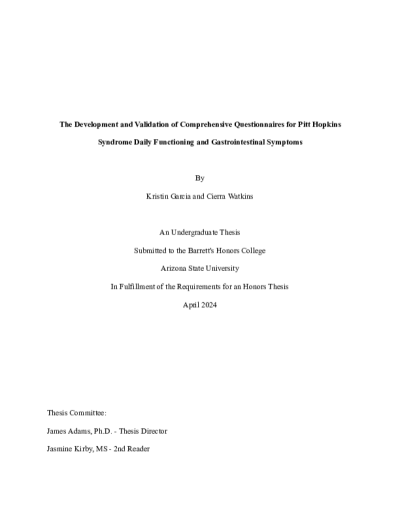Matching Items (1,812)
Filtering by
- Creators: School of Life Sciences
- Member of: Barrett, The Honors College Thesis/Creative Project Collection
Description
Ulaanbaatar, Mongolia is one of the world’s coldest capital cities with roughly 1.5 million residents. About fifty percent of the city’s residents are off the electrical grid and millions continue to live nomadic lifestyles, raising livestock for food. Problematically, residents often turn to raw coal - Mongolia’s largest export - as a means to cook food and stay warm. Project Koyash is a philanthropic engineering initiative that was founded in the Arizona State University Program Engineering Projects in Community Service (EPICS) to combat the air quality crisis plaguing the ger districts of Ulaanbaatar. Koyash has already deployed 13 fully functional and autonomous units consisting of a solar powered air filtration system in Ulaanbaatar. Koyash innovated a solution of solar panels, air filters, batteries, inverters, PCB Arduinos, and other necessary components for providing crucial humanitarian services. The team is working to send more units and develop a local supply chain for the systems. This thesis project explores the development of Koyash, assesses the human health implications of air pollution, and reflects on the entire process.
ContributorsYavari, Bryan (Author) / Hartwell, Leland (Thesis director) / Schoepf, Jared (Thesis director) / Diddle, Julianna (Committee member) / Barrett, The Honors College (Contributor) / Department of Psychology (Contributor) / School of Life Sciences (Contributor)
Created2024-05

Description
Pitt-Hopkins Syndrome is not a well-known disorder, and there are not many treatments dedicated to alleviating the severe symptoms that children and adults with Pitt-Hopkins Syndrome suffer through. The purpose of this study is to create questionnaires tailored to Pitt-Hopkins syndrome. With the dearth of Pitt-Hopkins Syndrome research, more knowledge on the disorder and treatments to aid in daily functioning and quality of life can be attained through specialized symptom tracking questionnaires. During this study, the research team designed and finalized two Pitt-Hopkins Syndrome symptom specific questionnaires. Some of the most notable results included the discovery of the most severe symptoms: verbal expression, cognition, social activity, and attention. Additionally, through cross-correlational analysis interrelated symptom clusters that can be targeted for treatment have been discovered.
ContributorsWatkins, Cierra (Author) / Garcia, Kristin (Co-author) / Adams, James (Thesis director) / Kirby, Jasmine (Committee member) / Barrett, The Honors College (Contributor) / School of Life Sciences (Contributor)
Created2024-05

ContributorsLuca, Michael (Author) / Yan, Hao (Thesis director) / Stephanopoulos, Nicholas (Committee member) / Blattman, Joseph (Committee member) / Barrett, The Honors College (Contributor) / School of Life Sciences (Contributor) / School of International Letters and Cultures (Contributor) / School of Molecular Sciences (Contributor)
Created2024-05
Description
Cell immunotherapies have revolutionized clinical oncology. While CAR T cell therapy has been very effective in clinical studies, off-target immune toxicity limits eligible patients. Thus, NK cells have been approached with the same therapy design since NK cells have a more favorable safety profile. Therefore, the purpose of this research project is to explore DNA nanotech-based NK cell engagers (NKCEs) that force an immunological synapse between the NK cell and the cancer cell, leading to cancer death. DNA tetrabody (TB) and DNA tetrahedron (TDN) are fabricated and armed with HER2 affibody for tight adhesion to HER2+ cancer cell lines like SKBR3. Overall, relationship between TB-NK treatment and cancer cell apoptosis is still unclear. TB-NK treatment induces an apoptotic profile similar to PMA/IO stimulation. Pilot cell assay needs to be replicated with additional controls and a shortened treatment window. For DNA TDN fabrication, HER2 affibody polishing with Ni-NTA affinity chromatography achieves high purity with 20% to 100% high-imidazole elution gradient. ssDNA-HER2 affibody conjugation is optimal when ssDNA is treated with 40-fold excess sulfo-SMCC for 4 hours. In conclusion, the manufacturing of DNA-based NKCEs is rapid and streamlined, which gives these NKCEs the potential to become a ready to use immunotherapy.
ContributorsLuca, Michael (Author) / Yan, Hao (Thesis director) / Stephanopoulos, Nicholas (Committee member) / Blattman, Joseph (Committee member) / Barrett, The Honors College (Contributor) / School of Life Sciences (Contributor) / School of International Letters and Cultures (Contributor) / School of Molecular Sciences (Contributor)
Created2024-05
Description
Alzheimer’s disease (AD) is projected to increase, and understanding risk and protective factors could help mitigate this increase. Deficits in Choline, a B-like vitamin, intake or issues with endogenous choline production can lead to an increased risk for AD development. To better understand the effects of endogenous choline through the lifespan in the context of Alzheimer pathology, Male and Female 3xTg-AD and NonTg mice, were aged to 16.81 ± 0.13 months. Body weight, food consumption data, and blood plasma samples were collected across the lifespan. A behavioral battery, that consisted of Rotarod, Elevated Plus Maze, and Intellicage, was performed to assess differences across a range of tasks. Hippocampal and cortical tissue were collected to assess pathology. Overall, 3xTg-AD mice had lower choline levels than NonTg at multiple timepoints and Males had higher choline than Females. Furthermore, 3xTg-AD Females had higher levels of both Aβ and Tau pathology than their Male counterparts. In the Intellicage, Females made fewer Percent of Correct Responses during Place Preference. Together these findings show that choline levels through the lifespan, impact the severity of pathology between Males and Female 3xTg-AD mice and behavioral differences between the 3xTg-AD and NonTg mouse models.
ContributorsMistry, Faizan (Author) / Velazquez, Ramon (Thesis director) / Judd, Jessica (Committee member) / Barrett, The Honors College (Contributor) / Department of Psychology (Contributor) / School of Life Sciences (Contributor)
Created2024-05

ContributorsLuca, Michael (Author) / Yan, Hao (Thesis director) / Stephanopoulos, Nicholas (Committee member) / Blattman, Joseph (Committee member) / Barrett, The Honors College (Contributor) / School of Life Sciences (Contributor) / School of International Letters and Cultures (Contributor) / School of Molecular Sciences (Contributor)
Created2024-05
Description
Background: Eosinophilic esophagitis (EoE) is an increasingly prevalent allergic disease characterized by eosinophilic inflammation and symptoms of esophageal dysfunction. Diagnosis and monitoring require repeated, invasive endoscopic esophageal biopsies to assess levels of eosinophilic inflammation. Recently, the minimally invasive esophageal string test (EST) has been used collect protein in mucosal secretions as a surrogate for tissue biopsies in monitoring disease activity. From the string, assessment of the eosinophil-associated proteins major basic protein-1 (MBP-1) and eotaxin-3 (Eot3) is used to assess disease activity; however, this requires measurement in a reference laboratory, for which the turnaround time for results exceeds the time required for histopathologic assessment of endoscopic biopsies. In addition, MBP-1 and Eot3 are not markers unique to eosinophils. These obstacles can be overcome by targeting eosinophil peroxidase (EPX), an eosinophil-specific protein, using a rapid point-of-care test. Currently, EPX is measured by a labor-intensive enzyme-linked immunosorbent assay (ELISA), but we sought to optimize a rapid point-of-care test to measure EPX in EST segments.
Methods: We extracted protein from residual EST segments and measured EPX levels by ELISA and a lateral flow assay (LFA).
Results: EPX levels measured by LFA strongly correlated with those quantified by ELISA
(rs = 0.90 {95% CI: 0.8283, 0.9466}). The EPX LFA is comparable to ELISA for measuring EPX levels in ESTs.
Conclusions: The EPX LFA can provide a way to rapidly test EPX levels in ESTs in clinical settings and may serve as a valuable tool to facilitate diagnosis and monitoring of EoE.
ContributorsDao, Adelyn (Author) / Lake, Douglas (Thesis director) / Borges, Chad (Committee member) / Wright, Benjamin (Committee member) / Barrett, The Honors College (Contributor) / School of Molecular Sciences (Contributor) / School of Life Sciences (Contributor)
Created2024-05
Description
This project challenges the prevailing weight-centric paradigm of present-day medicine which focuses on weight as a primary indicator of health. This study aimed to understand the impact of a brief pragmatic intervention to facilitate shifting healthcare providers' clinical conceptualization, attitudes, and practices from weight-centric to weight-inclusive care. A one-hour pragmatic training was composed and presented to providers at a community health clinic. The intervention highlighted the critical gap in our understanding of health and attempted to bring attention to the intricate web of factors that play into the complexity of weight. The education also provided specific tools that providers can put into practice to better cultivate weight-inclusive care. Mixed methods were used to evaluate the acceptability and efficacy of the intervention via changes in provider attitudes, treatment behaviors, and conceptualization of patient issues. Findings reveal modest differences from pre- to post-intervention as well as a notable disconnect among providers’ understanding and application of concepts. Participants expressed significant interest in the training and weight-inclusive care.
ContributorsZach, Rose (Author) / McEntee, Mindy (Thesis director) / May, Michelle (Committee member) / Barrett, The Honors College (Contributor) / School of Life Sciences (Contributor)
Created2024-05
ContributorsZach, Rose (Author) / McEntee, Mindy (Thesis director) / May, Michelle (Committee member) / Barrett, The Honors College (Contributor) / School of Life Sciences (Contributor)
Created2024-05
ContributorsZach, Rose (Author) / McEntee, Mindy (Thesis director) / May, Michelle (Committee member) / Barrett, The Honors College (Contributor) / School of Life Sciences (Contributor)
Created2024-05